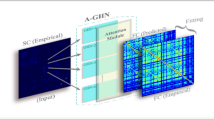Abstract
Deciphering the cause-and-effect relationships between brain regions not only can provide insights into the mechanism of brain networking but also facilitate the development of the brain-computer interface. Numerous studies have adopted effective connectivity measurements such as transfer entropy or multivariate autoregressive model to investigate the synchronous neuronal coupling across brain regions. Recent successes with representation learning in deep neural networks deserve further investigation on their capability for causal discovery. To this end, this study modified the Temporal Causal Discovery Framework (TCDF) with a sliding-window approach to explore the event-related intra-brain electroencephalogram (EEG) dynamics. The TCDF used a convolution neural network with an attention mechanism to predict causal direction among multi-channel time series data. The resultant array of attention scores was used to gauge the causality magnitude. The TCDF was first validated through a simulation study, followed by real EEG data collected in a virtual reality-based multitasking experiment. Results showed that the time-varying causality magnitudes were positively correlated with the predefined regression coefficients of simulated data, and the TCDF could successfully capture the coupling between brain regions, particularly for adjacent channels. However, some issues were raised in modeling as the number of channels increased or the causal order became larger. The current findings might shed some light on the development of deep learning-based causality analysis.
Access this chapter
Tax calculation will be finalised at checkout
Purchases are for personal use only
Similar content being viewed by others
References
Elman, J.L.: Finding structure in time. Cogn. Sci. 14(2), 179–211 (1990)
Shi, X., Chen, Z., Wang, H., Yeung, D.-Y., Wong, W.-K., Woo, W.-C.: Convolutional LSTM network: a machine learning approach for precipitation nowcasting. Adv. Neural. Inf. Process. Syst. 28, 802–810 (2015)
Kleinberg, S.: Why: A guide to finding and using causes. O'Reilly Media, Inc. (2015)
Vaswani, A., et al.: Attention is all you need. Adv. Neural. Inf. Process. Syst. 30, 6000–6010 (2017)
Watanabe, S., Hori, T., Kim, S., Hershey, J.R., Hayashi, T.: Hybrid CTC/attention architecture for end-to-end speech recognition. IEEE Journal of Selected Topics in Signal Processing 11(8), 1240–1253 (2017)
Xu, K., et al., Show, attend and tell: Neural image caption generation with visual attention. In: International Conference on Machine Learning, pp. 2048–2057. PMLR (2015)
Nauta, M., Bucur, D., Seifert, C.: Causal discovery with attention-based convolutional neural networks. Machine Learning and Knowledge Extraction 1(1), 312–340 (2019)
Delorme, A., Makeig, S.: EEGLAB: an open source toolbox for analysis of single-trial EEG dynamics including independent component analysis. J. Neurosci. Methods 134(1), 9–21 (2004)
Makeig, S., Bell, A., Jung, T.-P., Sejnowski, T.J.: Independent component analysis of electroencephalographic data. Adv. Neural. Inf. Process. Syst. 8, 145–151 (1995)
Acknowledgement
This work was supported by the Ministry of Science and Technology, Taiwan (project numbers: MOST 111-2636-E-007-020 and 110-2636-E-007-018), by the Research Center for Education and Mind Sciences, National Tsing Hua University, and by Yin Shu-Tien Educational Foundation.
Author information
Authors and Affiliations
Corresponding author
Editor information
Editors and Affiliations
Rights and permissions
Copyright information
© 2022 The Author(s), under exclusive license to Springer Nature Switzerland AG
About this paper
Cite this paper
Fang, SX., Chiu, TF., Huang, CS., Chuang, CH. (2022). Leveraging Temporal Causal Discovery Framework to Explore Event-Related EEG Connectivity. In: Stephanidis, C., Antona, M., Ntoa, S., Salvendy, G. (eds) HCI International 2022 – Late Breaking Posters. HCII 2022. Communications in Computer and Information Science, vol 1654. Springer, Cham. https://doi.org/10.1007/978-3-031-19679-9_4
Download citation
DOI: https://doi.org/10.1007/978-3-031-19679-9_4
Published:
Publisher Name: Springer, Cham
Print ISBN: 978-3-031-19678-2
Online ISBN: 978-3-031-19679-9
eBook Packages: Computer ScienceComputer Science (R0)




